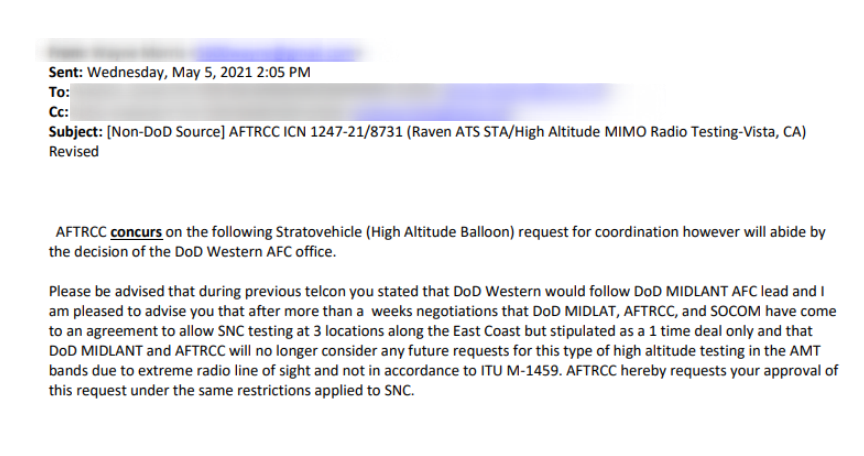The anticipation is growing as we wait for the report that is slated to be released June 1st. Take notes from the text below if you want some details beyond flying saucers and green people…
The sightings which are not only common in the United States but they too are reported by other countries across the globe. Will these sightings be fully explained? Not likely. So here is a primer for the reader to consider:
-
- We are often told that the weird things in the heavens above are weather balloons, so just accept that answer. Well, there are balloons in the skies and they are not commonly for weather. In fact, those balloons have some very secretive objectives.
These high-altitude balloons are the property of Raven Aerostar, a division of Raven Industries, based in Sioux Falls, South Dakota. In recent years, Raven Aerostar has been known for its collaboration with Google’s parent company Alphabet in Project Loon, an ambitious venture intended to extend Internet access to rural areas. The “Loon balloons” were designed by Raven Aerostar to fly at high altitude for extremely long durations. Project Loon announced it would shut down in January this year, despite making significant technical strides. Since then, Raven Aerostar has continued to develop its balloon technologies for other sectors, notably in the realm of intelligence and defense.
 ADSBExchange.com
ADSBExchange.comThe high altitude balloons as seen on flight trackers off Southern California. They have caught people’s attention especially due to the fact that they can stay on station for long periods of time, seemingly flying against the prevailing winds in the area.
The vehicles appear to be derivatives of Raven Aerostar’s Thunderhead balloon system. The Thunderhead balloons are designed to be able to persist over an area of interest in order to carry out a wide variety of tasks. According to the company, common applications include intelligence, surveillance, and reconnaissance (ISR) missions and acting as communications relays. Additionally, the balloons can also serve roles in augmenting navigational systems.
Their recent appearance over both coasts of the United States appears to be a test of exactly this networking capability. Federal Communications Commissions records reflect an approved license for one of Raven Aerostar’s subsidiaries, Aerostar Technical Solutions, to fly balloons within a two hundred-mile radius around Vista, California from May 9th until May 30th this year.
The stated purpose is to test networked radio systems, the Silvus 4400E and Silvus 4200E, on the high altitude balloons. Although the application only lists the California locations, further correspondence in FCC records show a conversation about permitting additional locations on the East Coast:
 Official Email
Official EmailThe company appears to have aggressively pursued its balloon testing in recent years, with experimental radio license applications dating back until at least February 2020. Balloon tests had previously been approved and conducted across the Southeast and Southwest. For example, residents of Jackson, Mississippi may have noticed a meandering balloon track around May 4th this year. Click here for more crazy details.
- In December 2020, the government enacted the Intelligence Authorization Act, which called for the release of an unclassified and all-sources report on unidentified aerial phenomenon (UAP) — the official military term used for unidentified flying objects. The act was included in the mammoth appropriations bill that also included financial aid checks for people living with the economic fallout from Covid-19.The report will include a thorough analysis of
- Available data
- Intelligence reporting on UAPs
It will be presented to the congressional intelligence and armed services committees on UAPs.
When the Pentagon officially released the footage of the unidentified aircraft last year, the agency admitted that the videos aren’t exactly sure what is going on in the video, and that they cannot explain how the crafts are able to pull such maneuvers.
It remains unclear whether the government believes these to be sightings of foreign aircrafts using technologies unfamiliar to the United States, or whether they believe the craft are not of this world.
- We are often told that the weird things in the heavens above are weather balloons, so just accept that answer. Well, there are balloons in the skies and they are not commonly for weather. In fact, those balloons have some very secretive objectives.
What else should we be asking? Well, the military and the intelligence community has some exceptional tools that are helpful in this quest so we may wonder if they are used in processing this report. Tools such as Geo-Spatial, DARPA, and then the known and unknown tools of the Space Force.
There is spacial wide-and communications, satellites (beyond line of sight) and geospatial intelligence that could or should be exploited in this mission of identification.
But wait…there are non-government agencies as well that often contract to government agencies such as Maxar.
From a 2019 blog post on the Maxar site is the following for consideration:
The Space Safety Coalition (SSC) issued the “Best Practices for Sustainability of Space Operations.” This document, co-signed by 21 space companies, advocates that any spacecraft operating at 400 kilometers or more above Earth should include a propulsion system for maneuvering, allowing each spacecraft to move itself out of a potential collision path instead of relying on others to always maneuver around it, as well as a number of other common sense principles. This will create a safer space environment for all to operate in now and for generations to come. Maxar Technologies fully endorses the “Best Practices for Sustainability of Space Operations” and encourages Congress to introduce legislation based on these best practices. Below is Maxar’s reasoning for supporting the “Endorsement of Best Practices for Sustainability of Space Operations.”
We rely on space for our everyday lives. Weather satellites enable us to forecast the next snowstorm, so we can stock up on food. GPS lets us navigate to a new destination, using maps that come from imaging satellites. GPS also provides the precise timing used for banking transactions and to make it possible for cell phones—and banking transactions—to work. And, of course, there is NFL Sunday Ticket on DirecTV.
Space is also a big place. To put this into context, between the lowest practical orbit (350 km above Earth’s surface) and geostationary orbit (100 times further up, at 35,000 km), the volume of “near Earth” space is about 270 times the volume of Earth! Current estimates indicate there’s 29,000 objects that are 4 inches or bigger being tracked in that space [1], so it seems like it would be pretty empty and we don’t have to worry about collisions, right?
Well, not exactly. There’s another aspect of space: orbital velocity. Satellites in space don’t stand still, but zip around in their orbits at high speed. In low earth orbit (closest to Earth’s gravitation pull), this is around 7.6 km/sec, or over 16,000 miles an hour! If two objects in space collide, it’s not a gentle nudge but rather a big resounding KABOOM. This results in a lot more small pieces of debris that need to be tracked. If you’re lucky, the collision may knock off a corner of your solar array, like happened when Maxar’s WorldView-2 satellite was hit back in 2016 by a small piece of debris. Fortunately, this had no impact on WorldView-2’s ability to operate. If you’re unlucky, you get a collision like the one between a defunct Russian Cosmos satellite and an Iridium communications satellite back in 2009, which was responsible for nearly doubling the amount of debris in that orbital band.
I’ve mentioned there are about 29,000 tracked objects in space. But there are a lot more pieces too small to track – an estimated 166 million pebble sized pieces [1] are zipping around in space.
While the probability of one of these pieces hitting a satellite is small (on the order of a million to one chance), each collision makes the problem worse. There’s actually a term for this, the Kessler Syndrome, in which each collision makes the problem exponentially worse. We don’t want that to happen, because if it did, it could make certain regions of near Earth space completely unusable for satellites or humans. Fortunately, we’re quite a long time away from space becoming unusable. Companies are creating new ways to track objects on orbit, including a new commercial solution Maxar is testing, which is the first step in containing the space debris problem. But space, similar to other common areas (like the oceans), requires responsible actions by all space operators to keep it usable for future generations. This is where rules of the road come in, and I’d like to lay out a few common sense ones:
- Propulsion. Spacecraft operating above 400 km altitude should be required to carry propulsion to executive timely and effective avoidance maneuvers. It’s simply not acceptable for a satellite operator to place the burden of avoiding a collision on other satellite operators; it’s everyone’s responsibility. This is why SSC‘s “Best Practices for Sustainability of Space Operations” advocates for spacecraft operators to adopt space operations concepts that enhance sustainability of the space environment. Why 400 kilometers? It’s a natural dividing line; the International Space Station operates at 403 km altitude (nobody wants to see the movie “Gravity” played out in real life), and below 400 km, atmospheric drag is enough to make those orbits “self-cleaning” (see below).
- Encryption. Satellites with propulsion should be required to have encryption and authentication on their command link, to ensure that only the satellite operator can control how the propulsion is used. We don’t want a hacker to take control of a satellite and maneuver it into the path of another one to cause an intentional collision.
- Navigation. Satellites with propulsion should be able to determine their position, and the operators of these satellites should be required to share this position data (along with any planned maneuvers) with a central repository, such as the Combined Space Operations Center (formerly known as the Joint Space Operations Center [JSpOC]), to facilitate safe navigation by all satellite operators. The U.S. government is working on a plan to move this repository to a civilian agency, such as the U.S. Department of Commerce, to enable a more open and accessible repository for all global satellite operators. This is akin to the use of automatic identification system (AIS) transponders in ocean-going vessels, which broadcast their location to other ships using AIS to enable safe navigation, and the data is available publicly online.
- Littering. Satellites and launch vehicles need to be designed so they do not throw off debris during or after launch. While already largely adopted, it’s important that launch providers and space operators have a plan to deorbit launch materials at the end of their life or move them to a safe orbit that’s out of the way and won’t have collision risks.
We could, however, designate the region below 400 km altitude as an “experimental” zone where the above requirements would not be imposed. These orbits are low enough that any debris will tend to reenter Earth’s atmosphere, burning up within weeks to months, making them much less of a concern. And few, if any, commercial or government satellites operate at those altitudes. Leaving the below-400 km region available without the above restrictions makes operating in space still affordable for operators of the growing number of inexpensive, experimental or educational cubesats.
The commercial and government use of space is accelerating rapidly. It’s time we have a way to regulate space traffic, just like how traffic on Earth is controlled. Even though the first gas-powered automobile was created in the 1880s, it took until the 1910s (three decades!) to bring some sensibility to who had the right-of-way on the road with the invention of the stop light.
Maxar along with the other co-signers of the SSC believe it’s time to bring sensibility to space. We’re asking the U.S. space industry to unite behind these best practices and talk to their senators and representatives about introducing legislation that reflect these best practices. We ask our international industry partners to bring these ideas to their respective governments for consideration. The “Best Practices for Sustainability of Space Operations” is a starting point to getting rules of the road established in space – but, in the big picture, all four common sense principles I’ve outlined above need to be implemented to keep space a safe environment available now and in the years to come.




 An officer speaks on walkie-talkie as the Bastion anti-ship missile systems take positions on the Alexandra Land island near Nagurskoye, Russia, Monday, May 17, 2021. Bristling with missiles and radar, Russia’s northernmost military base projects the country’s power and influence across the Arctic from a remote, desolate island amid an intensifying international competition for the region’s vast resources. Russia’s northernmost military outpost sits on the 80th parallel North, projecting power over wide swathes of Arctic amid an intensifying international rivalry over the polar region’s vast resources. (AP Photo/Alexander Zemlianichenko)
An officer speaks on walkie-talkie as the Bastion anti-ship missile systems take positions on the Alexandra Land island near Nagurskoye, Russia, Monday, May 17, 2021. Bristling with missiles and radar, Russia’s northernmost military base projects the country’s power and influence across the Arctic from a remote, desolate island amid an intensifying international competition for the region’s vast resources. Russia’s northernmost military outpost sits on the 80th parallel North, projecting power over wide swathes of Arctic amid an intensifying international rivalry over the polar region’s vast resources. (AP Photo/Alexander Zemlianichenko)